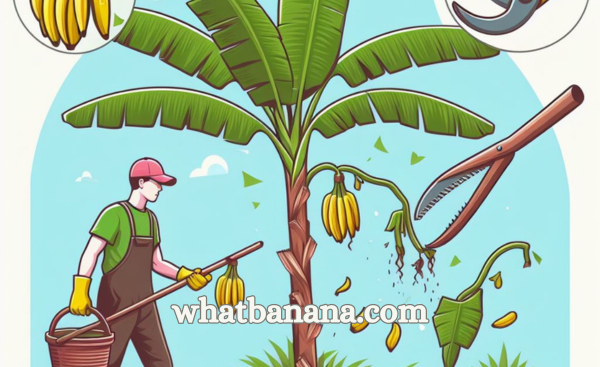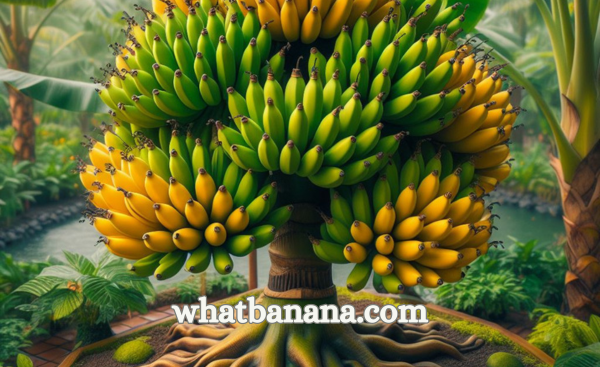Dwarf banana trees offer an exciting venture for gardening enthusiasts.
These compact plants not only fit into smaller spaces but also add a tropical flair to any setting.
This comprehensive guide on “Dwarf Banana Cultivation Tips” offers in-depth insights into selecting, planting, and caring for dwarf banana trees, ensuring a bountiful harvest even in small spaces.
Discover essential tips on propagation, overwintering, and overcoming common challenges to grow these tropical delights successfully.
Banana Bonanza: The Compact Guide to Growing Dwarf Bananas
Why Read This Article? If you’re looking to add a tropical flair to your garden with fruitful results, this article is a must-read.
It provides valuable, easy-to-follow instructions tailored for both beginners and seasoned gardeners to ensure your dwarf banana trees thrive and produce delicious bananas.
Dwarf Banana Tree Overview
Dwarf banana trees, belonging to the Musaceae family, are ideal for enthusiasts with limited space.
Originating from warm tropical and subtropical regions, these trees are known for their manageable size, ranging from 4 to 12 feet in height.
Popular varieties include Dwarf Cavendish, Lady Finger, and Red Tiger, each offering unique aesthetic and taste qualities.
These trees thrive in full sun to partial shade and prefer humid conditions with temperatures between 75-90°F.
They demand well-draining soil, rich in organic matter, and are susceptible to pests like nematodes and diseases like Panama disease
Selecting the Right Dwarf Banana Variety
Choosing the right dwarf banana variety is essential for successful cultivation.
The climate of your area and your taste preferences play a significant role in this decision.
Dwarf Cavendish is known for its sweet taste and manageable size, making it a popular choice.
Dwarf Brazilian offers unique flavors, while Dwarf Jamaican Red stands out with its distinctive red-skinned fruits.
Each variety has specific growth requirements, so it’s crucial to select one that matches your local climate and soil conditions.
Researching the specific needs of each variety will help you achieve a bountiful harvest
Planting Your Dwarf Banana Tree
Planting a dwarf banana tree requires careful consideration of location and soil.
Choose a spot that receives ample sunlight and has well-draining soil to avoid waterlogging, which can lead to root rot.
Dig a hole that is twice as wide and deep as the root ball of your tree.
Amend the soil with organic matter and a balanced fertilizer to give your tree a healthy start.
Carefully place the tree in the hole, backfill it with soil, and water it thoroughly.
Adding mulch around the base helps retain moisture and regulates soil temperature, providing an optimal growing environment.

Caring for Your Dwarf Banana Tree
Proper care is vital for the thriving of dwarf banana trees.
These tropical plants require consistent attention to ensure they grow healthily and yield a good crop of bananas.
Sunlight and Temperature: Dwarf banana trees flourish in full sun.
They need at least 8 hours of direct sunlight daily, which promotes healthy growth and fruiting.
The ideal temperature range for these trees is between 75-90 degrees Fahrenheit.
If you’re growing them in a region with cooler temperatures, especially during winter, consider moving them indoors or providing a protective cover.
Watering: Watering is a delicate balance.
These trees like their soil to be moist but not waterlogged, as too much water can lead to root rot.
On the other hand, under-watering can cause the tree to wilt and stunt its growth.
If you’re growing your banana tree in a pot, it may require more frequent watering since potting soil tends to dry out faster.
Ideally, water when the top half-inch to an inch of the soil feels dry.
Also, consider mulching to help retain soil moisture.
Soil and Fertilization: Dwarf banana trees prefer well-draining soil with a slightly acidic to neutral pH level of 5.5 to 7.
Before planting, enhance the soil with a mix of organic compost, vermiculite, or perlite to improve nutrient content and drainage.
Fertilization is crucial for these nutrient-hungry plants.
Use a high-phosphorous or balanced fertilizer like an 8-10-8 or 10-10-10 formula.
Younger plants need less fertilizer compared to mature ones.
If the goal is to encourage fruiting, opt for a high-potassium fertilizer.
Pruning and Maintenance: Regular pruning is necessary to remove dead or diseased leaves and to maintain the tree’s shape.
This also improves air circulation around the plant, reducing the risk of fungal diseases.
During the pruning process, inspect the tree for signs of pests or diseases and take appropriate action.
Adhering to these care guidelines ensures your dwarf banana tree remains healthy and productive.

Propagation and Repotting
Propagation of dwarf banana trees is commonly done through tissue culture or by using pups.
Tissue culture ensures the creation of genetically identical plants, ideal for maintaining consistency in fruit quality.
Pups, which are offshoots from the parent plant, can be carefully separated and replanted once they develop a few leaves.
This method is ideal for expanding your banana plantation or sharing with fellow gardeners.
When separating pups, ensure they have part of the corm and roots attached for successful transplantation.
Properly caring for these new plants is crucial for their development into fruitful trees.

Dwarf Banana Tree Fruiting and Harvesting
Harvesting dwarf bananas is an exciting phase of cultivation.
The fruits typically ripen on the tree within 6 to 9 months, depending on the variety and growing conditions.
The bananas are ready for harvest when they turn yellow and feel slightly soft.
Carefully cut the entire bunch from the tree and store it in a cool, dark place to complete the ripening process.
This patient waiting rewards you with sweet, homegrown bananas that can be enjoyed fresh or used in various recipes.
Regular monitoring of fruit development is essential to determine the perfect harvesting time.

Overwintering Dwarf Banana Trees
In regions with cold winters, special care is needed to overwinter dwarf banana trees.
For outdoor trees, apply a thick layer of mulch to protect the roots from freezing temperatures.
If temperatures drop significantly, consider digging up the tree and potting it indoors.
Indoor trees should be placed in a well-lit area and watered sparingly to prevent root rot while ensuring the soil doesn’t completely dry out.
Adjust your care routine based on the tree’s response to indoor conditions.
Proper overwintering ensures your banana trees survive the cold months and thrive in the following growing season.

Pest and Disease Management
Growing dwarf banana trees can be challenging due to their susceptibility to pests and diseases.
Regular monitoring and preventive measures are essential.
Common pests include aphids, which can spread diseases, and nematodes that affect the roots.
To control these, use organic insecticides or introduce natural predators like ladybugs.
Diseases such as root rot and leaf spot can be managed by ensuring proper soil drainage and air circulation.
Applying fungicides may also be necessary to control severe infections.
Adequate care and timely interventions can help maintain the health and productivity of your banana trees.

Frequently Asked Questions
Q: How long does it take for a dwarf banana tree to produce fruit?
A: Dwarf banana trees are relatively fast growers, typically taking 9 to 15 months to produce fruit. The exact time can vary based on the specific variety and growing conditions.
Q: Can dwarf banana trees be grown indoors?
A: Yes, dwarf banana trees can be grown indoors. They require a sunny location, like near a window, and consistent care similar to outdoor trees, including adequate watering, temperature, and fertilization.
Q: Do I need multiple dwarf banana trees to produce fruit?
A: No, you don’t need multiple trees. Dwarf banana trees are capable of self-pollinating, meaning they don’t require another tree nearby to produce fruit.
Q: What are common pests and diseases that affect dwarf banana trees?
A: Dwarf banana trees are commonly affected by pests like aphids, nematodes, and beetles, and diseases such as root rot and leaf spot. Regular monitoring and preventive measures are crucial for maintaining tree health.
My Final Thoughts
Dwarf banana trees are a rewarding addition to any garden.
With proper care, they can produce delicious fruits and enhance your garden’s aesthetics.
Remember, the key to successful cultivation lies in understanding and catering to the specific needs of your chosen variety.

Key Takeaways:
- Dwarf banana trees, ideal for small spaces, thrive in warm, sunny, and humid conditions.
- Selecting the right variety based on local climate and taste preferences is crucial.
- Proper planting in well-draining soil and consistent care including regular watering and fertilization are key.
- Dwarf bananas can be propagated through tissue culture or pups for continued growth.
- Harvesting occurs when bananas turn yellow and slightly soft, usually 9-15 months after planting.
- Pest and disease management is essential to maintain healthy plants.
- Overwintering strategies vary depending on climate; indoor care may be necessary in colder regions.
- Dwarf banana trees are self-pollinating and do not require multiple trees for fruit production.
